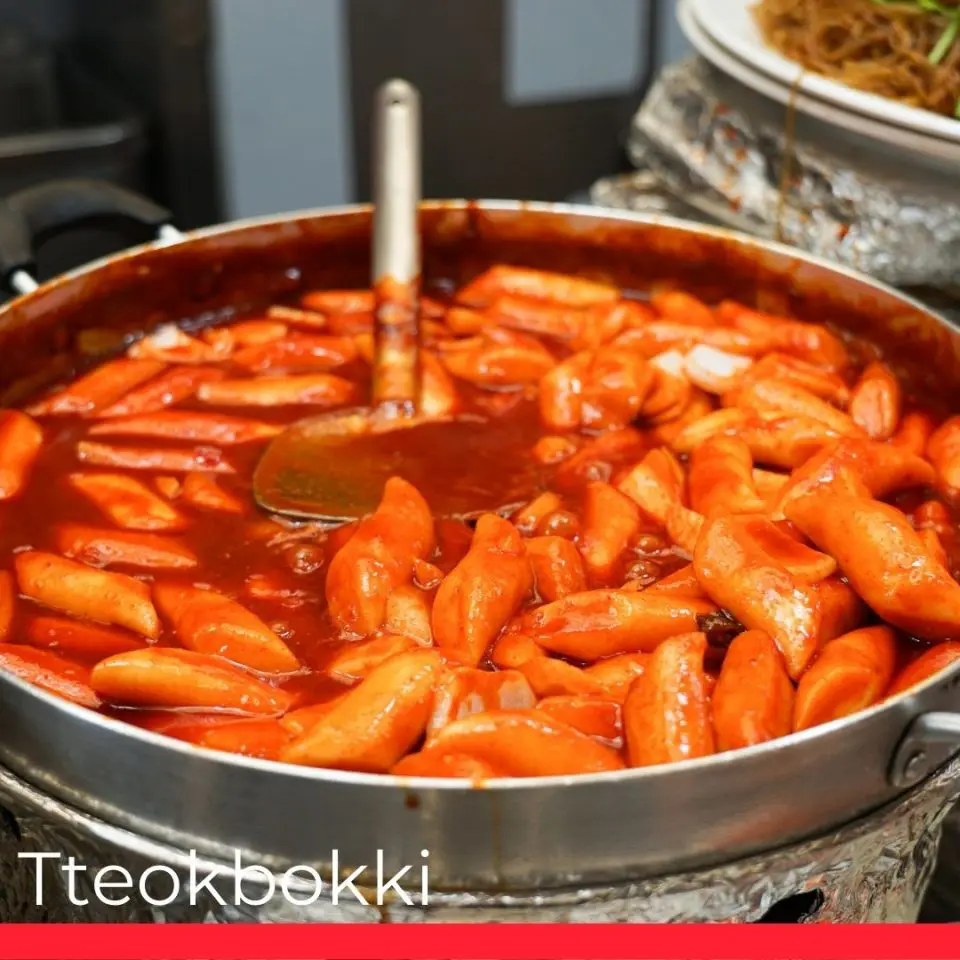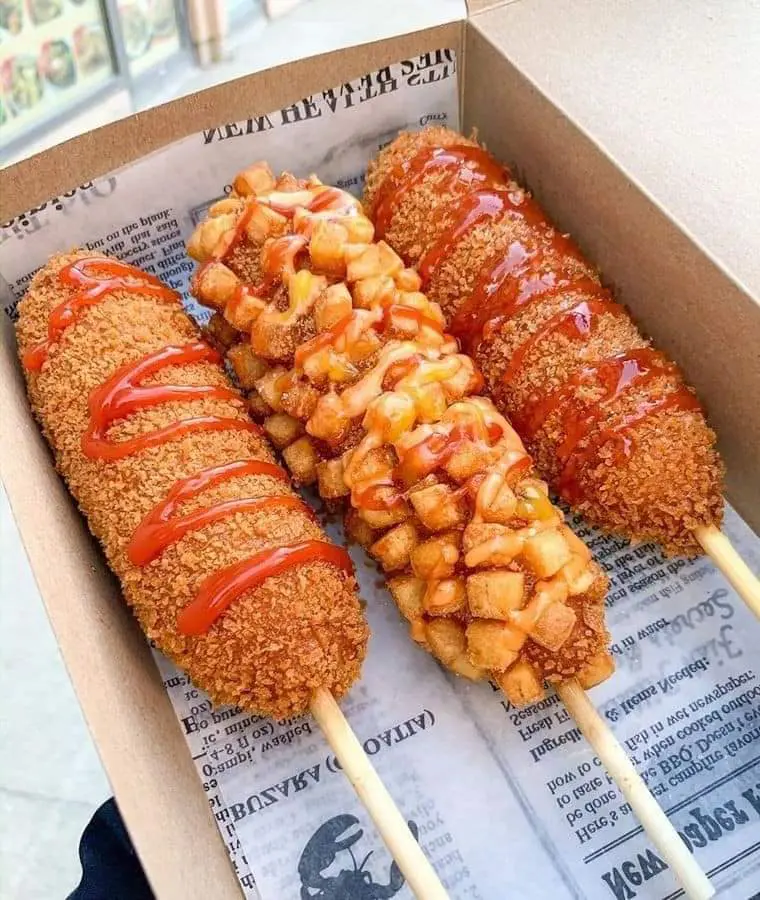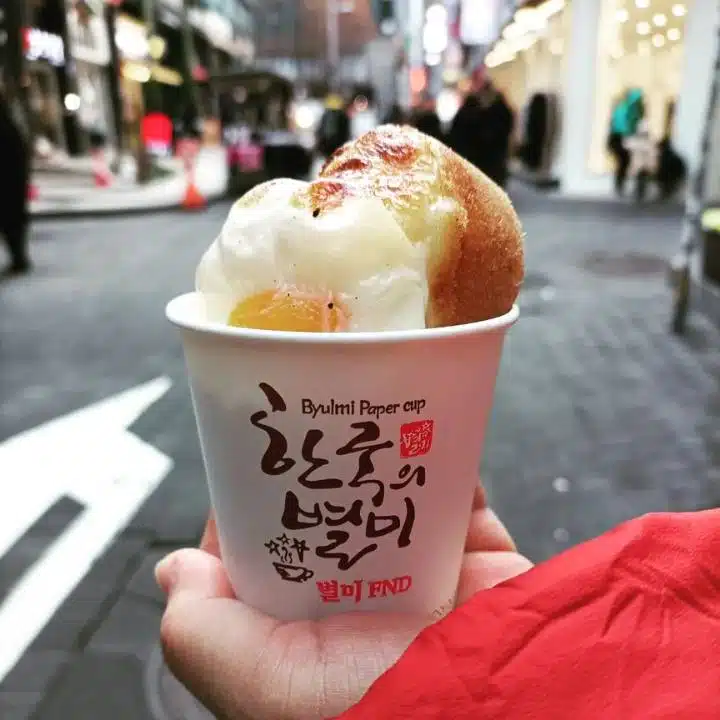If you have ever visited Korea, you’ve probably been amazed at the variety, the price, and the fantastic tastes of the nation’s street food. Korea is a street food heaven, and street food is regarded as a part of popular culture in Korea.
It is not clear when street food started to appear in Korea. However, the first stalls sprang up around traditional markets to provide fresh, economical snacks to shoppers.
After the Korean War (1950-1953), street food vendors provided affordable meals for people struggling to feed their families. Then, street food expanded into the Cheonggyecheon stream and Jongno districts, where today, locals and tourists can enjoy exploring famous street food alleys. Today, street food is regarded as a significant part of the Korean food culture.
So, let’s discover the best and must-eat Korean street food that will delight your taste buds!
Like a Meal (Meal-sized Street Food)
Did you think street food is only about tasty snacks between meals? No way! Please do not underestimate the versatility of street food. Some street food is perfect for breakfast, lunch, and dinner as it is filling enough for a whole meal.
Here are a few street food dishes commonly served as complete meals.
1. 떡볶이 (Tteokbokki: Spicy Stir-fried Rice Cakes)

Many people are familiar with the dish tteokbokki, especially those interested in Korean culture or who watch Korean movies or dramas.
These spicy rice cakes mixed with various ingredients are consistently ranked in the top 5 of Koreans’ most loved street food.
Have you already tried the classic tteokbokki? You can now try ‘fusion tteokbokki’, a delicious twist on the classic, such as Carbonara tteokbokki, Curry tteokbokki, and Bacon tteokbokki on the street. Does it sound off-beat? These creative dishes will delight your taste buds, and you will be pleasantly surprised at how well the flavors mesh together!
2. 순대 (Soondae: Korean Sausage)

Soondae is known as tteokbboki’s best friend. Yes, it goes so well with tteokbokki. You can easily find street vendors selling the combo – ‘tteok soon’ (tteok from tteokbokki, soon from soondae).
Soondae dipping sauces are different depending on the region in Korea. For example, when you order soondae from a street vendor in Seoul or Gyenggi province, salt is served for dipping. However, when you visit Busan, the second largest city in Korea, they will offer you soondae with makjang (a sauce made from doenjang and gochujang).
3. 컵밥 (Cupbab: Rice in a Cup)

This is a bowl of rice served with toppings. The only difference is that the bowl is replaced with a cup. In other words, a cupbab is rice topped with various toppings in a paper cup.
Students and those preparing for state exams often have cupbab for a meal as it’s cheap and tasty. Kimchi fried rice is usually the base and is topped with extra ingredients such as ham, sausage, eggs, or tuna.
4. 만두 (Mandu: Korean Dumplings)

Mandu are Korean dumplings commonly filled with minced meat (usually pork), tofu, green onions, garlic, and glass noodles. It’s another famous street food that is enjoyed as a complete meal.
In Korea, there are many varieties of Mandu, but usually, two types can be found on the street: meat dumplings and kimchi dumplings. You can go for one kind or ask the vendor to put half of each type in a takeaway box.
5. 닭강정 (Dakgangjeong: Sweet Crispy Korean Fried Chicken)

Dak means chicken in Korean, so this is a stir-fried chicken marinated in sauce. There are various sauces, but the most common dakgangjeong is sweet chili.
Some dakgangjeong street vendors are so popular that you’ll have to queue for hours to taste it. People even travel from other regions just to taste the dakganjeong sold at a specific famous street stall.
6. 어묵 (Eomuk: Korean Fish Cake)

Eomuk is a popular dish made with dough and powdered fish. Fish cakes are typically dipped in salty soy sauce seasoned with green onions and sesame oil. Fish cake skewers are among the cheapest foods on the street.
Fish cakes come in two distinctive types: folded and zigzagged, or elongated. The taste and size are similar, but the long fish cake can maintain a hot and fluffy texture for longer. On the other hand, the folded and zigzagged fish cake is well-simmered in broth and has a stronger umami taste.
7. 밥버거 (Bap Burger: Korean Rice Burger)

Bap means cooked rice, and burger means burger, as you already know! Bap burger is a popular Korean-style street food known for being very tasty and affordable. It is especially popular with students looking for a low-priced meal.
This dish is a burger with buns of compressed rice to hold the meat and veggies together. Koreans like to fill it with kimchi, tuna, spicy pork, or chicken with various vegetables between the rice buns, which are then toasted and scorched to give them a smokey flavor and crunchy texture.
8. 튀김 (Twigim: Korean Deep Fries)

Twigim in Korean refers to deep-fried dishes. The outer part of the batter is called ‘frying clothes’ (튀김 옷), and starch powder, bread crumbs, and flour are mainly used.
In general, twigim is sold by tteokbokki and soondae street vendors. The type of fried food depends on the main ingredient. Fried squid (오징어 튀김), fried vegetables (야채 튀김), fried sweet potatoes (고구마 튀김), and fried seaweed noodle rolls (김말이) are some examples. Why not try them all?
9. 빈대떡 (Bindaetteok: Mung Bean Pancakes)

This dish comprises ground mung beans mixed with vegetables or meat and fried in oil. It is greasy and savory, so it is also regarded as one of the best foods to enjoy when drinking alcohol.
In the past, meat was too expensive for most people. Therefore, they used meat scraps and fat to flavor their food. In this dish, the fat from the meat makes the pancake tastier, and the nutty taste and texture of the mung beans make it even more appealing.
As preparing it outdoors is straightforward, you’ll encounter bindaetteok in many open-air markets.
10. 길거리토스트 (Gilgeori Toast: Korean Street Toast)

Gilgeori toast, which means ‘street toast’ in Korean, is a savory and sweetened egg sandwich sold by street food vendors.
It is fast, easy, affordable, and can be eaten for breakfast or lunch.
Korean street toast is made by sprinkling ketchup and sugar on egg pancakes mixed with carrots.
For many Koreans, gilgeori toast is a nostalgic street food reminiscent of childhood. And despite some foreign visitors declaring, “It’s a sandwich, not a toast!”, it is most definitely a toast!
Korean Street Food Snacks
So, let’s imagine you are full up with the main meal you tasted on the street. Don’t worry, you will be hungry again and then you’ll be looking out for something to munch on once you’ve spent time visiting all the attractions. Keep your eyes open for these treats to sample!
11. 꽈배기(Kkwabaegi: Twisted Korean Doughnuts)

Kkwabaegi is a sweet, spongy, twisted snack you’ll find everywhere. It is made with a dough of glutinous rice flour, and melted butter that’s deep-fried in oil and then tossed in sugar and cinnamon powder.
Like most fried breads, it tastes much better when enjoyed comes straight out of the oil. If you are too full to eat it right away, then take it home for later – all it needs is to be heated up in a microwave or oven to reach the peak of yumminess again!
12. 닭꼬치 (Ddakkochi: Korean Chicken Skewers)

Ddakkochi is a popular grilled chicken snack on a stick. It is traditionally coated with an addictive sweet and spicy sauce. However, it sometimes comes simply seasoned with salt and no sauce. Some vendors even pour mustard sauce or mayonnaise over ddakkochi.
Some street vendors sell a very spicy version – bomb-flavored chicken skewers. These will test your spicy food tolerance, and they could have your eyes watering within seconds! However, if you fancy the challenge, go for bomb-flavored!
13. 감자 핫도그 (Gamja-Hotdog: Korean-style French Fries Corn Dog)

This is a fun Korean street food: a hot dog on a stick covered with French fries! Gamja means potatoes in Korean, so its name, gamja-hotdog, pretty much describes it.
Many foreigners who have visited Korea recommend gamja-hotdogs as the must-try Korean street food. They can be filled with either sausage or cheese, smothered in a sauce such as ketchup and mayonnaise, or even sprinkled with sugar, so experiment and find your favorite version!
14. 호떡 (Hotteok: Korean Sweet Pancakes)

Hotteok is a dessert snack filled with sweet syrup made from cinnamon, brown sugar, and peanuts. Nowadays, you can enjoy various types of hotteok as the original filling can be replaced with ice cream or cheese.
For those who prefer savory snacks, Japchae hottoek is filled with grass noodles mixed with soy sauce seasoning, veggies, and minced meat.
Check out our article on the most popular Korean desserts and sweets for more Korean sweet treats.
15. 계란빵 (Gyeran-Ppang: Egg Bread)

Gyeran means eggs in Korean, and ppang means bread. Egg bread sounds as simple as the recipe, but the taste is anything as it’s an intriguing mix of sweet and savory.
The dough is made with flour, baking powder, milk, eggs, butter, sugar, and salt. Then, it is put in the Gyeran-ppang machine, and a whole egg is cracked onto the bread batter. Finally, it is cooked until golden brown.
This snack is particularly popular during winter as it is warm and comforting.
16. 찐빵 (Jjinppang: Korean Steamed Buns)

Jjinbbang was first introduced to the Korean peninsula around 250 years ago. Since then, it has grown in popularity and become one of Koreans’ favorite snacks. It is typically filled with sweetened red bean paste, vegetables, and different types of meat.
Steaming jjinppang makes an ideal snack in the cold winter months as you hold it with your bare hands, warming up your frosty fingers. And, of course, the sweet, comforting filling will help your body warm and relax too.
17. 국화빵 (Gukhwa-Ppang: Chrysanthemum Bread)

Bread with chrysanthemum? It sounds a bit weird, but don’t worry! Gukhwa-ppang doesn’t contain any flowers at all! Instead, it got its name because the pattern on the bread resembles that of a flower.
Initially, only red beans were added, but now a wider variety of ingredients, such as honey, peanuts, and walnuts, are used.
18. 붕어빵 (Bungeo-Ppang: Korean Fish Shaped Pastry)

Bungeo-ppang is very similar to gukhwa-ppang. However, while gukhwa-ppang is put in a chrysanthemum-shaped mold, bungeo-ppang is fish shaped. There is one more thing in terms of the difference between them: the texture. Bungeo-ppang is crispier than gukhwa-ppang, which has a thicker and softer dough.
It is also regarded as a winter snack in Korea, so finding a street vendor selling classic bungeo-ppang in summer is challenging. However, you can still enjoy a variation in the hotter months – there’s a vanilla ice-cream version of bungeo-ppang called bungeo samanco (붕어 싸만코), which you can find at any convenience store 24/7.
19. 구운 가래떡 (Guwun Garaetteok: Korean Grilled Bar Rice Cake)

Garaetteok is one of the simplest types of rice cake, and it’s the quality of the rice that determines the taste. Garae rice cake is grilled on briquettes or charcoal until it becomes crisp on the outside and remains soft on the inside. Then, you can enjoy it with honey, syrup, or sugar.
20. 군고구마 (Gun Goguma: Roasted Sweet Potatoes)

Many countries use roasted sweet potatoes as a meal or snack. However, this Korean street snack differs from others due to a particular cooking method: the Drum Can.
You’ll see many roasted sweet potato stands on the street, using metal drum cans. Some sellers offer gun goguma with honey and butter, which makes them taste incredible!
21. 핫바 (Hot Bar)

Hot bar is deep-fried fish paste served on a stick or skewer. Other ingredients are added for more variety in flavors, including cheese, rice cake, perilla leaf, chili, seaweed, sausage, or ham.
When you order a hot bar from a street vendor, it is usually made on the spot, as the mixed paste is fried with white ground fish, flour, eggs, and vegetables. If you wish to try other ingredients, ask the seller to put them inside the paste.
Take a bite of a freshly fried and steaming hot bar, and you’ll go straight to foodie heaven!
22. 달고나 (Dalgona: Korean Sponge Candy)

Dalgona resembles honeycomb toffee candy. It’s made by melting sugar with a bit of baking soda.
You can often see sellers making different patterns on the candy, such as a star, heart, or fish, before it hardens completely. Some vendors will even offer a fun challenge – get free candy if you can eat the candy around the pattern without cracking it.
Depending on the region, it is sometimes called ppopgi (뽑기).
23. 소떡소떡 (Sotteok Sotteok: Korean Hotdog and Rice Cake Skewers)

The name sotteok sotteok is derived from the preparation method. ‘So'(소) is from sausage, and ‘tteok’ (떡) means Korean rice cake. Sausages and rice cakes are skewered in turns and then fried or grilled. They’re coated with ketchup, mustard, or red pepper paste-based spices.
24. 뻥튀기 (Bbeongtwigi: Korean Puffed Rice)

Bbeongtwigi is made of puffed rice. The name bbeongtwigi comes from twigi, to puff, and the sound ‘bbeong’.
What has sound got to do with anything? Well, when you put rice (or any other grain) inside a puffing machine, a big piece of bbeongtwigi comes out with a big “bbeong” sound!
It is very crispy and then becomes a bit sticky in your mouth. Vendor trucks often move between towns selling puffed rice and grains.
25. 회오리 감자 (Hweori Gamja: Tonado potatoes)

The last on our list is hwori gamja, also known as tornado potato or spiral potato.
A whole potato is cut into a spiral on a machine, then fried on a skewer and brushed with various seasonings like onion or cheese. Then there is hweori gamja, which has a sausage in the middle – irresistible comfort food!
Have we missed your favorite Korean street food off our list? Let us know in the comments below and share your ‘must-try’ snacks with our community!
Related: 10 Popular Korean Drinks (Alcoholic and Non-Alcoholic)
Related: 10 Delicious Korean Stews & Soups

The post Top 25 Most Popular Korean Street Foods appeared first on Chef's Pencil.
from Chef's Pencil https://ift.tt/VdsIwGt
via https://chefsspenncil.blogspot.com

No comments:
Post a Comment